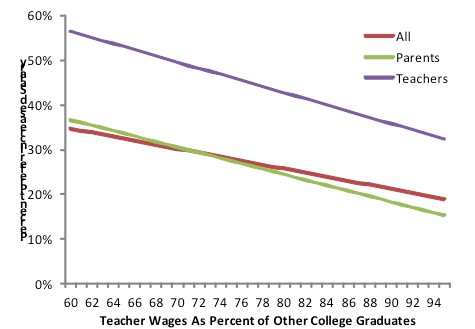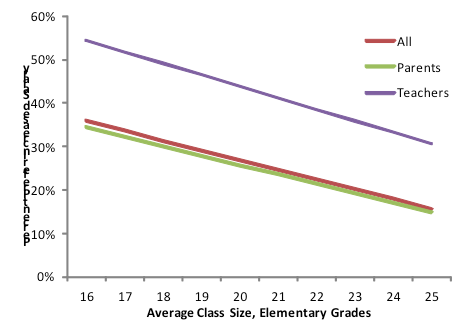Earlier today, I wrote on the Brown Center Chalkboard about how teachers and parents are more likely to accept increases in class size in order to protect other educational programs when the costs are known. The 2011 Education Next-PEPG survey found that teachers were about evenly split in the preferences for a $10,000 raise as compared to three-student decrease in class size—policies which have roughly the same cost.
These data indicate that about half of teachers do not think smaller classes are worth the cost (relative to the alternative of a salary increase), and a substantial minority of parents hold the same view. But presumably the desirability of increasing class size in order to fund higher salaries is different in schools with different salaries and class sizes.
I investigate this question by examining the relationship between the percent of respondents preferring salary increases over class-size reduction in the 2011 Education Next-PEPG survey and average teacher compensation and class size in their state. The teacher compensation data indicate how much teachers earn each week compared to other college graduates in their state and are based on Census data from 2006 to 2010.[1] The class size data are based on a survey of teachers administered in 2007-08.

These data indicate that support for higher salaries over smaller classes is strongest, on average, in states with lower salaries and smaller classes.[2] In states where teachers are paid the least well, about 35 percent of the public is expected to prefer higher salaries, a slight majority of respondents who expressed an opinion one way or the other (a sizable number of respondents expressed no opinion). Preferences lean more toward smaller classes in states where teachers are paid relatively well.
Teachers have higher levels of support for increasing salaries over decreasing class size, but the pattern with regard to average relative pay in the state is similar. A clear majority prefers a raise to a smaller class in states where teachers are poorly paid, but in states where relative pay is better, the improved working condition (class size) is preferred to higher pay.

A similar pattern holds for average class size in the elementary grades.[3] Residents of states with smaller classes tend to be more amenable to modest increases in class size in order to boost teacher salaries. Conversely, it is not surprising that there is more resistance to increasing class size in states that already have larger classes.[4]
States will continue to face hard choices about how to spend limited educational dollars in the coming years. Allowing class size to increase by modest amounts may be the best way to offset budget cuts in some places, especially states that already have quite small classes or pay their teachers relatively poorly. Fortunately, these are also the states with the best chance for gaining political support from parents, teachers, and the general public to accept increases in class size in order to sustain wiser investments of public resources.
-Matt Chingos
- [1] Accurately comparing the wages of teachers and other workers is challenging given that most teachers do not work year-round and benefit packages likely differ in the public and private sectors. However, for the purpose of my analysis it is only important that the teacher compensation measure is comparable across states, not that it accurately capture the absolute difference in wages between teachers and other workers.
- [2] The figures show the estimated relationship between share supporting increased salary and either relative teacher pay or average class size in the state. All six of the relationships shown in the figures are statistically significant at the 5 percent level, with standard errors adjusted for clustering by state.
- [3] I also find a statistically significant relationship between respondent preferences and class size at the secondary level for parents and teachers, but not for respondents overall.
- [4] The similar relationship for relative pay and average class size is not a function of these variables being highly correlated; they are only weakly correlated (r=0.15).


